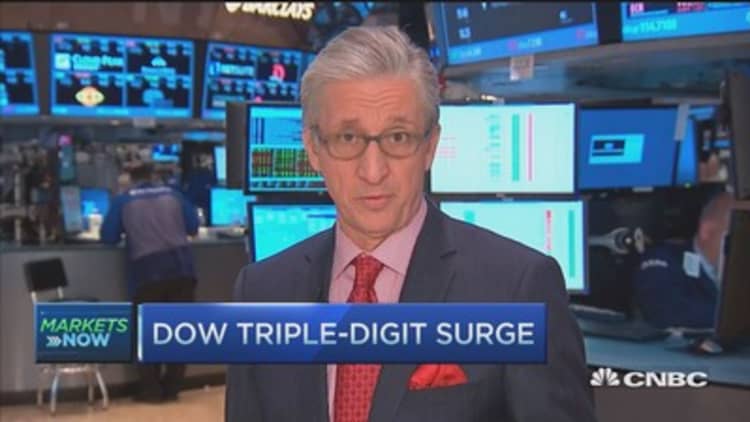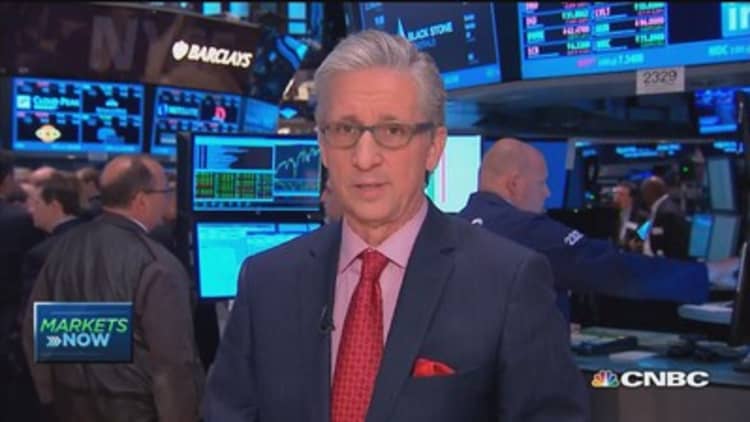


U.S. stocks closed about 1 percent higher on Friday, recovering from Thursday's selloff, as investors eyed higher Treasury yields and looked for signs of economic growth. (Tweet This)
"We're just having a bounce from a rough week," said Peter Boockvar, chief market analyst at The Lindsey Group. "It's the first day of the month. There's no real news."
He noted that Friday's gains were modest and concentrated in the large caps. "It's concerning that interest rates are going higher when (the economic data is weak)."
The Dow Jones Industrial Average closed up more than 180 points as the major indices recovered the prior day's losses.
The Nasdaq outperformed, boosted by the same biotech and tech sectors that dragged the index down on Thursday. The iShares Nasdaq Biotechnology ETF gained more than 3 percent, just about recovering its losses from the prior day. Apple recouped recent losses to close up 3 percent at $128.95 a share.
The S&P 500 held above 2,100, a key level TD Ameritrade chief strategist JJ Kinahan was watching. Besides trying to interpret the bond market, he said, "I think people are going to position themselves ahead of employment (next Friday)."
The important monthly jobs report for April comes out next Friday morning and will indicate whether or not the first quarter slowdown could continue into the rest of the year.
Read MoreStocks entering May with low expectations
Stocks were still negative for the week, with the Nasdaq down 1.70 percent and the S&P 500 down 0.44 percent. The Dow was off 0.31 percent for the week.
"Signs of exhaustion have arisen on the 30-minute chart of the S&P futures, supporting an oversold bounce today," BTIG's chief technical strategist Katie Stockton said in a morning note. "The lack of upside follow-through after last week's breakout from a triangle pattern is a little concerning, but there is support nearby and we expect momentum to improve next week. Overbought conditions are far from widespread and earnings have generally been well-received, so we would use weakness to add exposure."
U.S. Treasury yields continued to gain, with the 10-year briefly topping 2.12 percent, nearly an eight-week high.
Eric Stein, co-director of global income at Eaton Vance Management, cited several reasons for the selloff in the bond market. "I think the Fed statement was at the margin hawkish," he said, highlighting the removal of all calendar references to a rate hike. "The data continues to be mixed." Low jobless claims and a 0.7 percent gain in the employment cost index on Thursday are other factors for the bond selloff, he said.
US 10-year Treasury yield performance year-to-date
"I think that the yield curve factor comes into play and that could restrain stocks as the market prepares for a change in monetary policy," said Peter Cardiillo, chief market economist at Rockwell Global Capital. He said with most earnings out of the way, the market would focus on the lower guidance and economic data.
However, some analysts are still optimistic. Tom Digenan, head of US equities for UBS Global Asset Management, said that longer term "I do think in the second quarter and more in the third and fourth quarter you'll see top-line growth."
Companies attributed misses on lowered revenue expectations to the strong dollar, which is up 9.5 percent for the last six months.
The U.S. dollar weakened this week but recovered on Friday, rising against the yen. The euro fell below $1.12.
On Thursday, the major indices closed below their 50-day moving averages, with biotechs sending the Nasdaq down 82.22 points, or 1.6 percent, recovering slightly from a 2 percent dip. The Dow Jones Industrial Average closed down 1.1 percent, with Apple down 2.7 percent as the greatest laggard.
"I think the market is starting to realize there's lower growth ahead," said Nick Raich, CEO of The Earnings Scout. "The earnings are turning (in beats) but the second quarter estimates are coming in lower."
April auto sales showed an annual rate of 16.45 million, Autodata said. The figure was slightly below estimates but still a 4.6 percent gain from the same period last year. General Motors and Ford reported stronger-than-expected U.S. auto sales, with GM sales up nearly 6 percent and Ford posting a 5.4 percent gain from the same month last year. Fiat Chrysler and Nissan reported an increase of 5.8 and 5.7 percent, respectively. Toyota missed expectations, up 1.8 percent versus an increase of 5.9 percent.
Expansion in the U.S. manufacturing sector weakened in April as growth in output and new orders fell, according financial data firm Markit. The report said the final U.S. Manufacturing Purchasing Managers' Index fell to 54.1 in April from 55.7 in March. The preliminary read was 54.2.
On the back of disappointing first-quarter GDP data, April's index missed slightly, coming in at 51.5, unchanged from the previous month. The report was expected to show a modest rise to 52 that would follow five consecutive months of weakening.
Construction spending data for March showed a decline of 0.6 percent. The University of Michigan's consumer sentiment survey for April showed a final read of 95.9, up from 93.0 in March.
Read MoreElectricity usage predicts stock direction: Paper
Requiring the Federal Reserve to operate according to a monetary policy rule could generate worse economic outcomes than using a goal-based mandate like an inflation target, San Francisco Fed President John Williams said in remarks prepared for delivery at Chapman University.
Earlier, Cleveland Fed President Loretta Mester said the central bank needs a clearer understanding of how problems in housing—stemming from changes in household finance—might destabilize the U.S. economy. Mester is an alternate voting member of the Federal Reserve Open Market Committee.
Mester also said the Federal Reserve is getting close to the appropriate time to raise interest rates and all policy meetings, including June's, are "on the table for a move."
Oil remains in focus as prices continued to hold near highs. Crude pulled back slightly, settling down 0.8 percent at $59.15 a barrel after hitting an intraday record for 2015 of $59.90 a barrel.
Yum Brands jumped nearly 7 percent to highs not seen since its spinoff from PepsiCo on news that Dan Loeb's Third Point took a significant stake in the firm. The hedge fund also announced a stake in Devon Energy.
Shares of tank car makers Greenbrier, Trinity Industries, Wabtec and American Railcar jumped on news of .
Chevron, Clorox and Public Service were among the few companies reporting before market open.
Oil and natural gas producer Chevron posted a 43 percent drop in quarterly profit on Friday due to low oil prices. The company reported net income of $2.57 billion, or $1.37 per share, compared to $4.51 billion, or $2.36 per share, in the year-ago period. Production grew 4 percent to 2.68 million barrels of oil equivalent per day.
Moody's closed 0.30 percent lower after posting earnings of $1.11 per share for its latest quarter, beating estimates by 8 cents, with revenue also well above estimates. Its results were powered by strong increases in both debt rating and analytics revenue.
VF Corp closed down half a percent after the firm matched estimates with quarterly profit of 67 cents per share, with revenue very slightly below Street forecasts due to international weakness. However, the North Face and Timberland maker also increased its full-year earnings forecast.
CVS Health closed up 1.18 percent after reporting earnings of an adjusted $1.14 per share for its latest quarter, 6 cents above estimates, while revenue also beat analyst forecasts. The company's results were helped by stronger specialty pharmacy results, but it gave a current quarter view that falls below Street forecasts.
Read MoreEarly movers: NWL, MCO, VFC, CVS, LNKD, AIG & more
The Dow Jones Industrial Average closed up 183.54 points, or 1.03 percent, at 18,024.06, with Apple leading blue chips higher, with Chevron the greatest of three laggards.
The closed up 22.78 points, or 1.09 percent, at 2,108.29, with materials leading nine sectors higher and telecommunications the only laggard.
The Nasdaq closed up 63.97 points, or 1.29 percent, at 5,005.39.
The CBOE Volatility Index (VIX), widely considered the best gauge of fear in the market, traded around 13.
Three stocks advanced for every two decliners on the New York Stock Exchange, with an exchange volume of 743 million and a composite volume of nearly 3.4 billion in the close.
High-frequency trading accounted for 47.5 percent of April's daily trading volume of about 6.4 billion shares, according to TABB Group. Total volume was slightly lower than March's 6.7 billion shares. During the peak levels of high-frequency trading in 2009, about 61 percent of 9.8 billion of average daily shares traded were executed by high-frequency traders.
Gold futures settled down $7.90 at $1,174.50 an ounce on the New York Mercantile Exchange.
In Europe, U.K. equities ended higher. The majority of European markets, and many international markets, were closed for the International Workers' Day holiday.
Wednesday's weaker-than-expected GDP report and Fed meeting statement that removed all calendar references to an interest rate hike has put investors on edge ahead of a key economic indicator—April's jobs report due next Friday. The data could indicate a pickup in the second quarter and could bring a rate hike forward.
—Reuters and CNBC's Peter Schacknow contributed to this report
More From CNBC.com:


